Estimation of Potential Nitrous Oxide Emissions from Landfills in the United States: 2010–2020
Abstract
:1. Introduction
- (1)
- Estimate N2O emissions from landfills across the U.S. using comprehensive data on waste generation and disposal.
- (2)
- Determine N2O emissions from landfills by state and facility from 2010 to 2020, considering temporal and spatial variations.
- (3)
- Assess the environmental costs associated with N2O emissions from landfills and evaluate their impact on changes in the U.S. greenhouse gas inventory when applied.
2. Materials and Methods
2.1. Research Design
2.2. N2O Estimation Method
2.3. Data Collection
2.4. Data Analysis
3. Results and Discussion
3.1. General Trend of Nitrous Oxide Emissions from Landfills in the United States
3.2. Regional Specific Trend of Nitrous Oxide Emission from Landfills in the United States
3.3. The Impact of Including N2O Emissions in Greenhouse Gas Inventory
4. Conclusions
Author Contributions
Funding
Data Availability Statement
Conflicts of Interest
References
- Allen, M.R.; Braithwaite, A.; Hills, C.C. Trace Organic Compounds in Landfill Gas at Seven U.K. Waste Disposal Sites. Environ. Sci. Technol. 1997, 31, 1054–1061. [Google Scholar] [CrossRef]
- Gautam, K.; Pandey, N.; Yadav, D.; Parthasarathi, R.; Turner, A.; Anbumani, S.; Jha, A.N. Ecotoxicological impacts of landfill sites: Towards risk assessment, mitigation policies and the role of artificial intelligence. Sci. Total Environ. 2024, 927, 171804. [Google Scholar] [CrossRef] [PubMed]
- Guo, H.; Xu, H.; Liu, J.; Nie, X.; Li, X.; Shu, T.; Bai, B.; Ma, X.; Yao, Y. Greenhouse Gas Emissions in the Process of Landfill Disposal in China. Energies 2022, 15, 6711. [Google Scholar] [CrossRef]
- Ham, R.K.; Norman, M.R.; Fritschel, P.R. Chemical Characterization of Fresh Kills Landfill Refuse and Extracts. J. Environ. Eng. 1993, 119, 1176–1195. [Google Scholar] [CrossRef]
- Ito, A.; Takahashi, I.; Nagata, Y.; Chiba, K.; Haraguchi, H. Spatial and temporal characteristics of urban atmospheric methane in Nagoya City, Japan: An assessment of the contribution from regional landfills. Atmos. Environ. 2001, 35, 3137–3144. [Google Scholar] [CrossRef]
- Lee, N.H.; Song, S.H.; Jung, M.J.; Kim, R.H.; Park, J.K. Dynamic emissions of N2O from solid waste landfills: A review. Environ. Eng. Res. 2023, 28, 220630. [Google Scholar] [CrossRef]
- Manheim, D.C.; Yeşiller, N.; Hanson, J.L. Gas Emissions from Municipal Solid Waste Landfills: A Comprehensive Review and Analysis of Global Data. J. Indian Inst. Sci. 2021, 101, 625–657. [Google Scholar] [CrossRef]
- Park, J.W.; Shin, H.C. Surface emission of landfill gas from solid waste landfill. Atmos. Environ. 2001, 35, 3445–3451. [Google Scholar] [CrossRef]
- Son, Y.-S.; Kim, J.-C.; Kim, K.-H.; Lim, B.-A.; Park, K.-N.; Lee, W.-K. The Composition of Odor Compounds Emitted from Municipal Solid Waste Landfill. J. Korean Soc. Atmos. Environ. 2007, 23, 666–674. [Google Scholar] [CrossRef]
- Abiriga, D.; Vestgarden, L.S.; Klempe, H. Groundwater contamination from a municipal landfill: Effect of age, landfill closure, and season on groundwater chemistry. Sci. Total Environ. 2020, 737, 140307. [Google Scholar] [CrossRef]
- Dagwar, P.P.; Dutta, D. Landfill leachate a potential challenge towards sustainable environmental management. Sci. Total Environ. 2024, 926, 171668. [Google Scholar] [CrossRef] [PubMed]
- Iravanian, A.; Ravari, S.O. Types of Contamination in Landfills and Effects on The Environment: A Review Study. IOP Conf. Ser. Earth Environ. Sci. 2020, 614, 012083. [Google Scholar] [CrossRef]
- OECD. Stat: Municipal Waste, Generation and Treatment. 2024. Available online: https://stats.oecd.org/index.aspx?DataSetCode=MUNW# (accessed on 22 March 2024).
- Ezyske, C.M.; Deng, Y. Landfill Management and Remediation Practices in New Jersey, United States. In Management of Organic Waste; Montclair State University: Montclair, NJ, USA, 2012. [Google Scholar] [CrossRef]
- Hanson, D.L.; Caponi, F.R. US landfill disposal: The big picture. J. Munic. Waste Prof. 2008, 18, 297–336. [Google Scholar]
- Powell, J.T.; Pons, J.C.; Chertow, M. Waste Informatics: Establishing Characteristics of Contemporary U.S. Landfill Quantities and Practices. Environ. Sci. Technol. 2016, 50, 10877–10884. [Google Scholar] [CrossRef] [PubMed]
- Bowman, J. The Methanotrophs—The Families Methylococcaceae and Methylocystaceae. Prokaryotes 2006, 266–289. [Google Scholar] [CrossRef] [PubMed]
- Gebert, J.; Groengroeft, A. Passive landfill gas emission—Influence of atmospheric pressure and implications for the operation of methane-oxidising biofilters. Waste Manag. 2006, 26, 245–251. [Google Scholar] [CrossRef] [PubMed]
- Hanson, R.S.; Hanson, T.E. Methanotrophic bacteria. Microbiol. Rev. 1996, 60, 439–471. [Google Scholar] [CrossRef] [PubMed]
- Zhang, C.; Xu, T.; Feng, H.; Chen, S. Greenhouse Gas Emissions from Landfills: A Review and Bibliometric Analysis. Sustainability 2019, 11, 2282. [Google Scholar] [CrossRef]
- Scheutz, C.; Kjeldsen, P.; Bogner, J.E.; Visscher ADe Gebert, J.; Hilger, H.A.; Huber-Humer, M.; Spokas, K. Microbial methane oxidation processes and technologies for mitigation of landfill gas emissions. Waste Manag. Res. 2009, 27, 409–455. [Google Scholar] [CrossRef]
- Barlaz, M.A.; Green, R.B.; Chanton, J.P.; Goldsmith, C.D.; Hater, G.R. Evaluation of a Biologically Active Cover for Mitigation of Landfill Gas Emissions. Environ. Sci. Technol. 2004, 38, 4891–4899. [Google Scholar] [CrossRef]
- Reinhart, D.R.; Cooper, D.C.; Walker, B.L. Flux Chamber Design and Operation for the Measurement of Municipal Solid Waste Landfill Gas Emission Rates. J. Air Waste Manag. Assoc. 2012, 42, 1067–1070. [Google Scholar] [CrossRef]
- Scheutz, C.; Kjeldsen, P. Guidelines for landfill gas emission monitoring using the tracer gas dispersion method. Waste Manag. 2019, 85, 351–360. [Google Scholar] [CrossRef] [PubMed]
- IPCC. Climate Change 2014: Synthesis Report; IPCC: Geneva, Switzerland, 2014. [Google Scholar]
- Kirchmann, H.; Widen, P. Separately collected organic household wastes. Chemical composition and composting characteristics. Swed. J. Agric. Res. 1994, 24, 3–12. [Google Scholar]
- Schenk, M.K.; Appel, S.; Daum, D. N2O emissions during composting of organic waste (Refereed)). Acta Hortic. 1997, 450, 262. [Google Scholar] [CrossRef]
- Daskalopoulos, E.; Badr, O.; Probert, S.D. Municipal solid waste: A prediction methodology for the generation rate and composition in the European Union countries and the United States of America. Resour. Conserv. Recycl. 1998, 24, 155–166. [Google Scholar] [CrossRef]
- Wang, X.; Jia, M.; Zhang, H.; Pan, S.; Kao, C.M.; Chen, S. Quantifying N2O emissions and production pathways from fresh waste during the initial stage of disposal to a landfill. Waste Manag. 2017, 63, 3–10. [Google Scholar] [CrossRef]
- Rinne, J.; Pihlatie, M.; Lohila, A.; Thum, T.; Aurela, M.; Tuovinen, J.-P.; Laurila, T.; Vesala, T. Nitrous Oxide Emissions from a Municipal Landfill. Environ. Sci. Technol. 2005, 39, 7790–7793. [Google Scholar] [CrossRef]
- Börjesson, G.; Svensson, B.H. Nitrous oxide emissions from landfill cover soils in Sweden. Tellus Ser. B Chem. Phys. Meteorol. 1997, 49, 357–363. [Google Scholar] [CrossRef]
- Harborth, P.; Fuß, R.; Münnich, K.; Flessa, H.; Fricke, K. Spatial variability of nitrous oxide and methane emissions from an MBT landfill in operation: Strong N2O hotspots at the working face. Waste Manag. 2013, 33, 2099–2107. [Google Scholar] [CrossRef]
- Tsujimoto, Y.; Masuda, J.; Fukuyama, J.; Ito, H. N2O emissions at solid waste disposal sites in Osaka City. J. Air Waste Manag. Assoc. 1994, 44, 1313–1314. [Google Scholar] [CrossRef]
- IPCC. IPCC Expert Meeting for Technical Assessment of IPCC Inventory Guidelines (Energy, IPPU, Waste Sectors); IPCC: Geneva, Switzerland, 2015. [Google Scholar]
- U.S. Environmental Protection Agency. Inventory of U.S. Greenhouse Gas Emissions and Sinks: 1990–2019; U.S. Environmental Protection Agency: Washington, DC, USA, 2021.
- Zhou, D.; Meinke, H.; Wilson, M.; Marcelis, L.F.M.; Heuvelink, E. Towards Delivering on the Sustainable Development Goals in Greenhouse Production Systems. Resour. Conserv. Recycl. 2021, 169, 105379. [Google Scholar] [CrossRef]
- Yaman, C.; Anil, I.; Alagha, O. Potential for Greenhouse Gas Reduction and Energy Recovery from MSW through Different Waste Management Technologies. J. Clean. Prod. 2020, 264, 121432. [Google Scholar] [CrossRef]
- Calderón Márquez, A.J.; Cassettari Filho, P.C.; Rutkowski, E.W.; de Lima Isaac, R. Landfill Mining as a Strategic Tool towards Global Sustainable Development. J. Clean. Prod. 2019, 226, 1102–1115. [Google Scholar] [CrossRef]
- Ali, S.M.; Appolloni, A.; Cavallaro, F.; D’Adamo, I.; Di Vaio, A.; Ferella, F.; Gastaldi, M.; Ikram, M.; Kumar, N.M.; Martin, M.A.; et al. Development Goals towards Sustainability. Sustainability 2023, 15, 9443. [Google Scholar] [CrossRef]
- IPCC. Climate Change 2007 Synthesis Report; IPCC: Geneva, Switzerland, 2007. [Google Scholar]
- United Nations Framework Convention on Climate Change. Approved Baseline and Monitoring Methodology AM0083 “Avoidance of Landfill Gas Emissions by In-Situ Aeration of Landfills”; United Nations Framework Convention on Climate Change: Bonn, Germany, 2009.
- Ritchie, H.; Roser, M. CO2 and Greenhouse Gas Emissions. Our World in Data. 11 May 2020. Available online: https://ourworldindata.org/co2-and-other-greenhouse-gas-emissions (accessed on 24 March 2024).
- Mudhoo, A.; Sewhoo, B.; Mohee, R.; Gurjar, B.R. Greenhouse gas emissions reductions from in-situ aeration in a landfill: A multi-parameter sensitivity analysis approach. J. Environ. Inform. 2013, 22, 78–91. [Google Scholar] [CrossRef]
- IPCC. 2006 IPCC Guidelines for National Greenhouse Gas Inventories Volume 5: Waste Chapter 3: Solid Waste Disposal; IPCC: Geneva, Switzerland, 2006. [Google Scholar]
- IPCC. IPCC Second Assessment Climate Change 1995; IPCC: Geneva, Switzerland, 1995. [Google Scholar]
- U.S. Environmental Protection Agency. Landfill Technical Data; U.S. Environmental Protection Agency: Washington, DC, USA, 2021. Available online: https://www.epa.gov/lmop/landfill-technical-data (accessed on 23 March 2024).
- Hassan, S.H.; Halim, A.A.; Yusoff, M.S.; Wang, L.K.; Wang, M.-H.S. Legislation for Solid Waste Management. In Solid Waste Engineering and Management: Volume 1; Spring: Berlin/Heidelberg, Germany, 2021; pp. 85–141. [Google Scholar] [CrossRef]
- Contreras, M.; Gázquez, M.J.; Romero, M.; Bolívar, J.P. Recycling of industrial wastes for value-added applications in clay-based ceramic products: A global review (2015–19). New Mater. Civ. Eng. 2020, 155–219. [Google Scholar] [CrossRef]
- ReFED. A Roadmap to Reduce U.S. Food Waste by 20 Percent. 2016. Available online: https://refed.org/downloads/ReFED_Report_2016.pdf (accessed on 23 March 2024).
- Yang, X.; Choi, H.S.; Park, C.; Kim, S.W. Current states and prospects of organic waste utilization for biorefineries. Renew. Sustain. Energy Rev. 2015, 49, 335–349. [Google Scholar] [CrossRef]
- Burns & McDonnell 2013 Statewide Waste Characterization, St. Paul 2013, MN. Available online: https://www.pca.state.mn.us/sites/default/files/w-sw1-60.pdf (accessed on 1 March 2024).
- Pennsylvania Department of Environmental Protection. Statewide Waste Composition Study; Pennsylvania Department of Environmental Protection: Harrisburg, PA, USA, 2018.
- Iowa Department of Natural Resources. Iowa Statewide Waste Characterization Study 2017; Iowa Department of Natural Resources: Des Moines, IA, USA, 2017.
- Delaware Solid Waste Authority Statewide Waste Characterization Study, FY 2016. 2017. Available online: https://dswa.com/wp-content/uploads/2017/02/Final-Report-DSWA-Waste-Characterization-FY-2016-January-2017.pdf (accessed on 21 February 2024).
- Economic Impact of Recycling in Alabama and Opportunities for Growth. 2012. Available online: http://adem.alabama.gov/programs/land/landforms/CompleteEconomicsOfRecyclingAlabamaReport.pdf (accessed on 22 February 2024).
- Economic Impact Potential and Characterization of Municipal Solid Waste in Michigan 2016. Available online: https://www.michigan.gov/-/media/Project/Websites/egle/Documents/Programs/draft/480236-14-WMSBF-waste-characterization-report.PDF?rev=ae29ca79e78e4b93861ecc9efc34cd08 (accessed on 22 February 2024).
- Fairbanks North Star Borough Recycling Plan & Analysis. 2015. Available online: https://www.fnsb.gov/DocumentCenter/View/1262/2015-PDC-Recycling-Plan-and-Analysis-PDF (accessed on 23 February 2024).
- Illinois Commodity/Waste Generation and Characterization Study Update. 2015. Available online: https://illinoisrecycles.org/wp-content/uploads/2014/10/2015-Waste-Characterization-Update-FINAL.pdf (accessed on 24 February 2024).
- Abramowitz, H.; Sun, Y. Municipal solid waste characterization study for Indiana. In Theses and Dissertations Available from ProQuest; Purdue University: West Lafayette, IN, USA, 2012. [Google Scholar]
- Rhode Island Solid Waste Characterization Study. 2015. Available online: https://www.rirrc.org/sites/default/files/2017-02/WasteCharacterizationStudy2015.pdf (accessed on 23 March 2024).
- U.S. Environmental Protection Agency. Advancing Sustainable Materials Management: 2018 Tables and Figures; U.S. Environmental Protection Agency: Washington, DC, USA, 2020.
- US Census. City and Town Population Totals: 2010–2019; US Census: Suitland, MD, USA, 2021. Available online: https://www.census.gov/data/tables/time-series/demo/popest/2010s-total-cities-and-towns.html (accessed on 21 March 2024).
- US Census. State Area Measurements and Internal Point Coordinates; US Census: Suitland, MD, USA, 2021. Available online: https://www.census.gov/geographies/reference-files/2010/geo/state-area.html (accessed on 22 March 2024).
- US Census. Understanding the Population of the U.S. Virgin Islands; US Census: Suitland, MD, USA, 2021.
- US Census. State Population Totals and Components of Change: 2010–2019; US Census: Suitland, MD, USA, 2021. Available online: https://www.census.gov/data/tables/time-series/demo/popest/2010s-state-total.html (accessed on 22 March 2024).
- Environmental Research & Education Foundation. Analysis of MSW Landfill Tipping Fees-April 2019; Environmental Research & Education Foundation: Raleigh, NC, USA, 2020. [Google Scholar]
- Zero Waste Strategies. Road to Zero Waste Plan. 2013. Available online: http://www.zerowasteassociates.com (accessed on 24 March 2024).
- Bogner, J.E.; Spokas, K.A.; Chanton, J.P. Seasonal Greenhouse Gas Emissions (Methane, Carbon Dioxide, Nitrous Oxide) from Engineered Landfills: Daily, Intermediate, and Final California Cover Soils. J. Environ. Qual. 2011, 40, 1010–1020. [Google Scholar] [CrossRef]
- U.S. Environmental Protection Agency. Municipal Solid Waste Generation, Recycling, and Disposal in the United States: Facts and Figures; U.S. Environmental Protection Agency: Washington, DC, USA, 2014.
- Interface. A Look Back: Interface’s Sustainability Journey. 2019. Available online: https://www.interface.com.cn/page/interfacestory (accessed on 25 February 2024).
- Blair, J.; Mataraarachchi, S. A Review of Landfills, Waste and the Nearly Forgotten Nexus with Climate Change. Environments 2021, 8, 73. [Google Scholar] [CrossRef]
- Lee, U.; Han, J.; Wang, M. Evaluation of landfill gas emissions from municipal solid waste landfills for the life-cycle analysis of waste-to-energy pathways. J. Clean. Prod. 2017, 166, 335–342. [Google Scholar] [CrossRef]
- Angeles, L.; Karadimas, N.V.; Loumos, V.G. GIS-based modelling for the estimation of municipal solid waste generation and collection. Waste Manag. Res. 2008, 26, 337–346. [Google Scholar] [CrossRef] [PubMed]
- Matsunaga, K.; Themelis, N.J. Effects of affluence and population density on waste generation and disposal of municipal solid wastes. Earth Eng. Cent. Rep. 2002, 1, 1–29. Available online: https://www.researchgate.net/publication/228908198 (accessed on 26 February 2024).
- Vijay, R.; Gupta, A.; Kalamdhad, A.S.; Devotta, S. Estimation and allocation of solid waste to bin through geographical information systems. Waste Manag. Res. 2005, 23, 479–484. [Google Scholar] [CrossRef] [PubMed]
- Abdel-Shafy, H.I.; Mansour, M.S.M. Solid waste issue: Sources, composition, disposal, recycling, and valorization. Egypt. J. Pet. 2018, 27, 1275–1290. [Google Scholar] [CrossRef]
- OECD. Working Group on Waste Prevention and Recycling EPR Policies and Product Design: Economic Theory and Selected Case Studies. 2006. Available online: www.oecd.org/env/waste (accessed on 22 March 2024).
- Duan, Z.; Scheutz, C.; Kjeldsen, P. Trace gas emissions from municipal solid waste landfills: A review. Waste Manag. 2021, 119, 39–62. [Google Scholar] [CrossRef]
- Huang, D.; Du, Y.; Xu, Q.; Ko, J.H. Quantification and control of gaseous emissions from solid waste landfill surfaces. J. Environ. Manag. 2022, 302, 114001. [Google Scholar] [CrossRef]

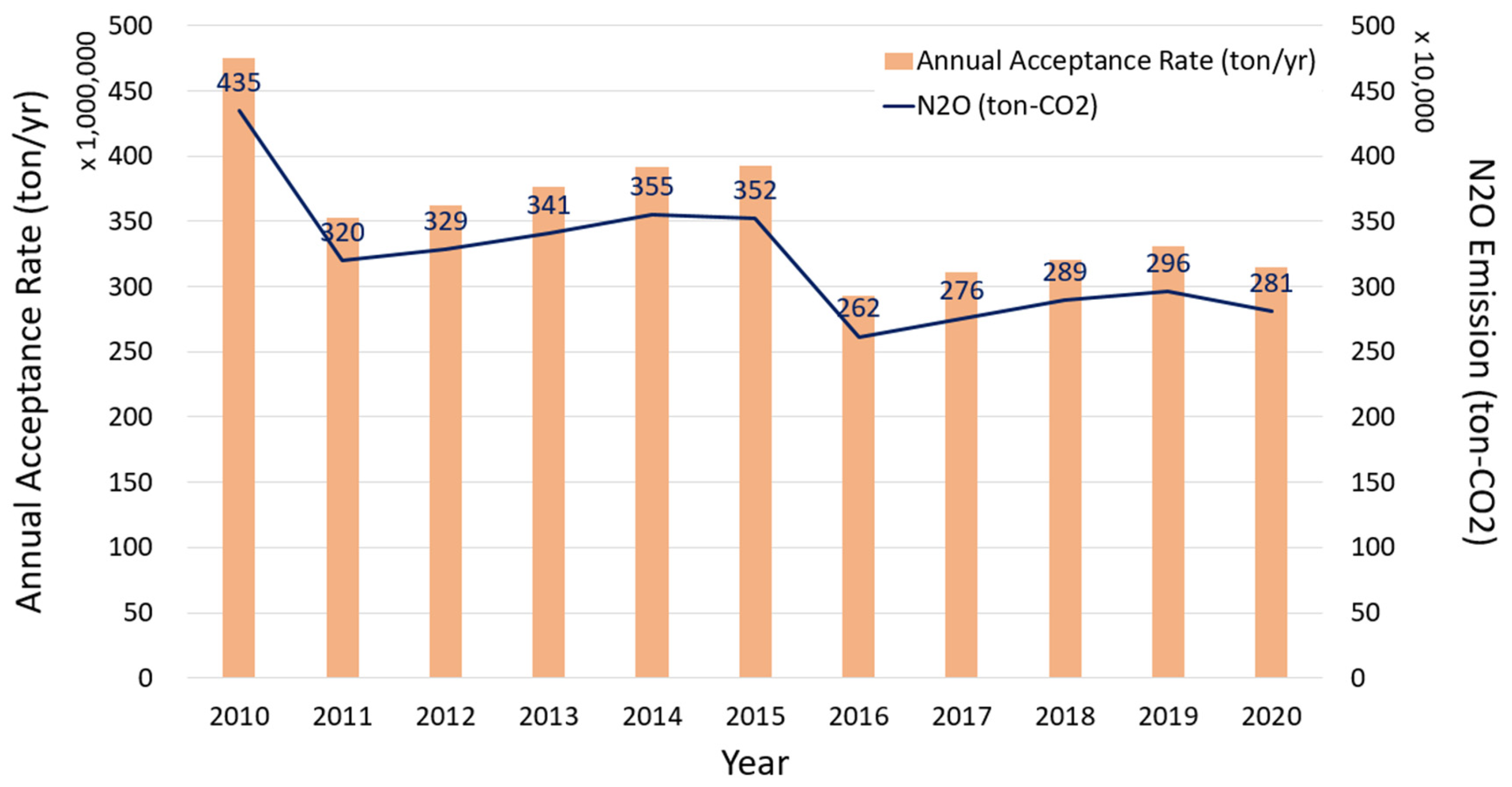
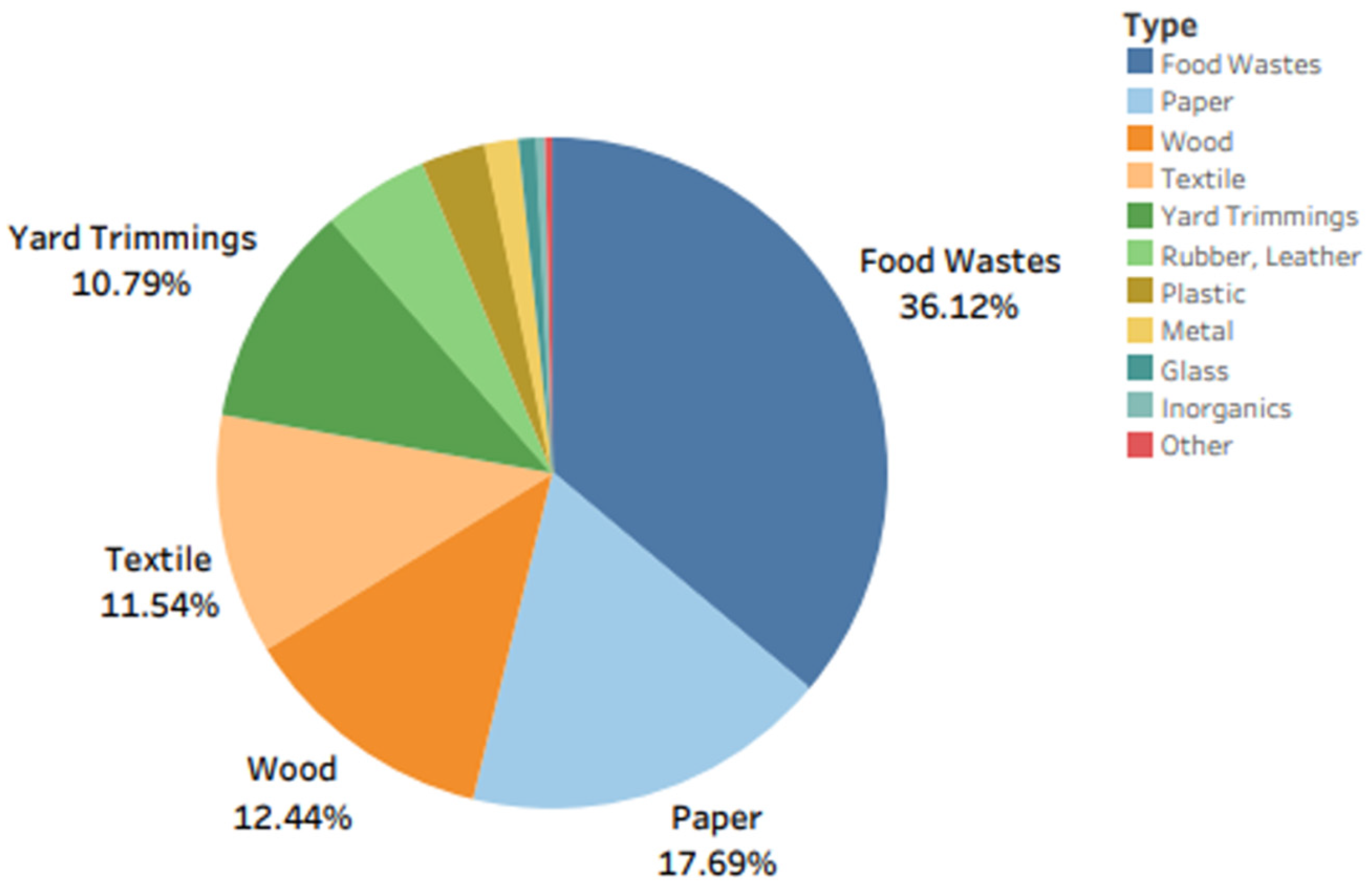
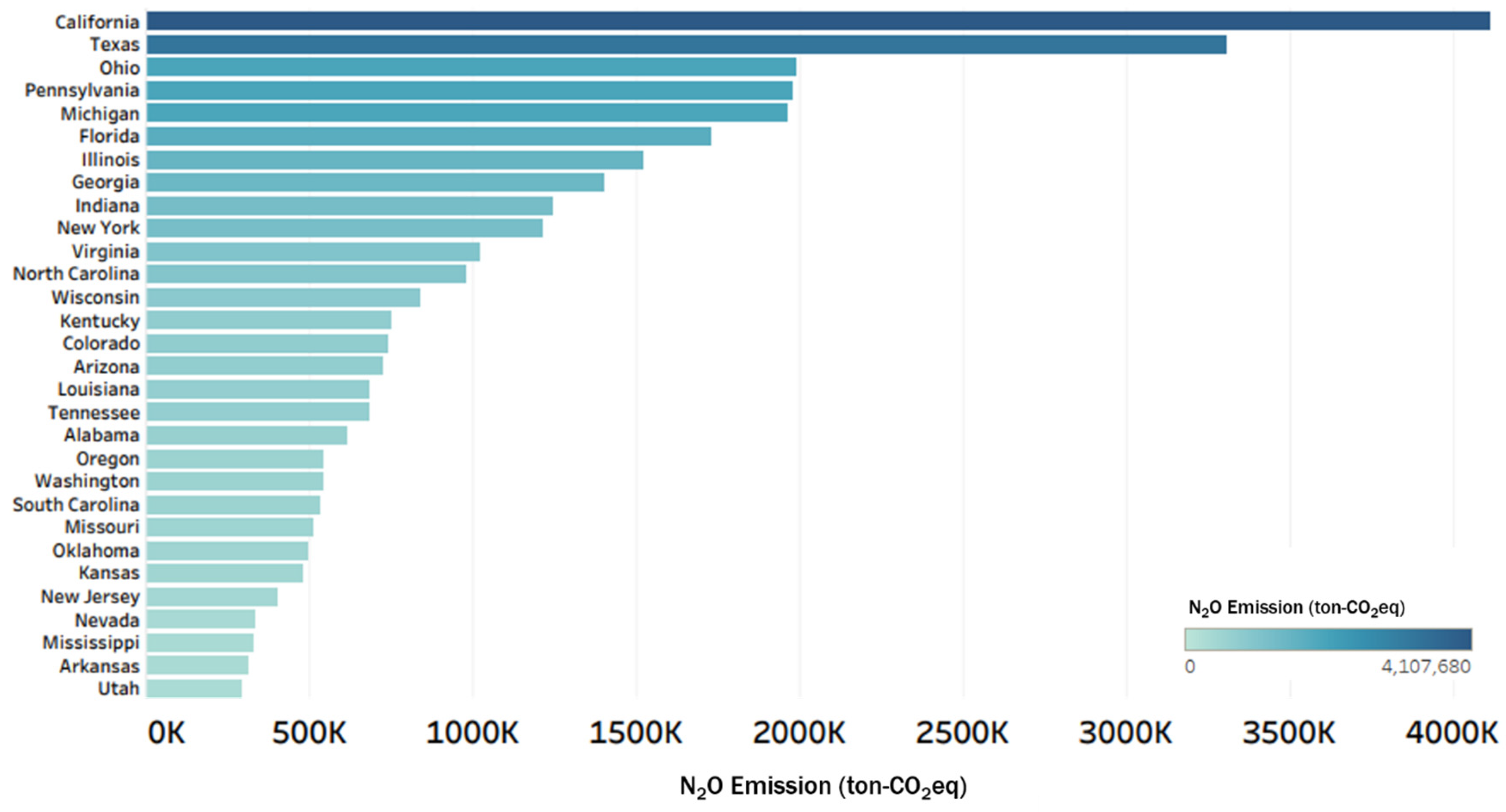
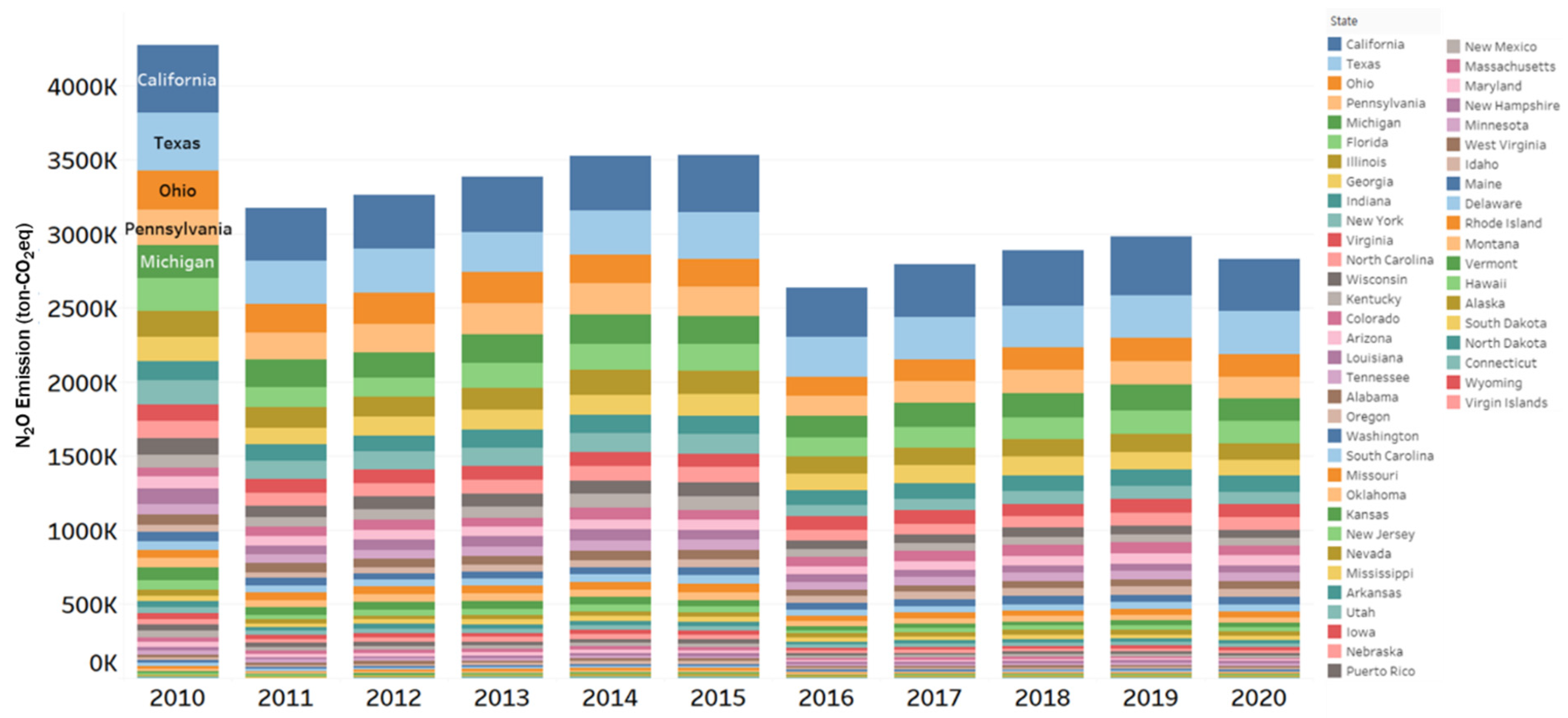
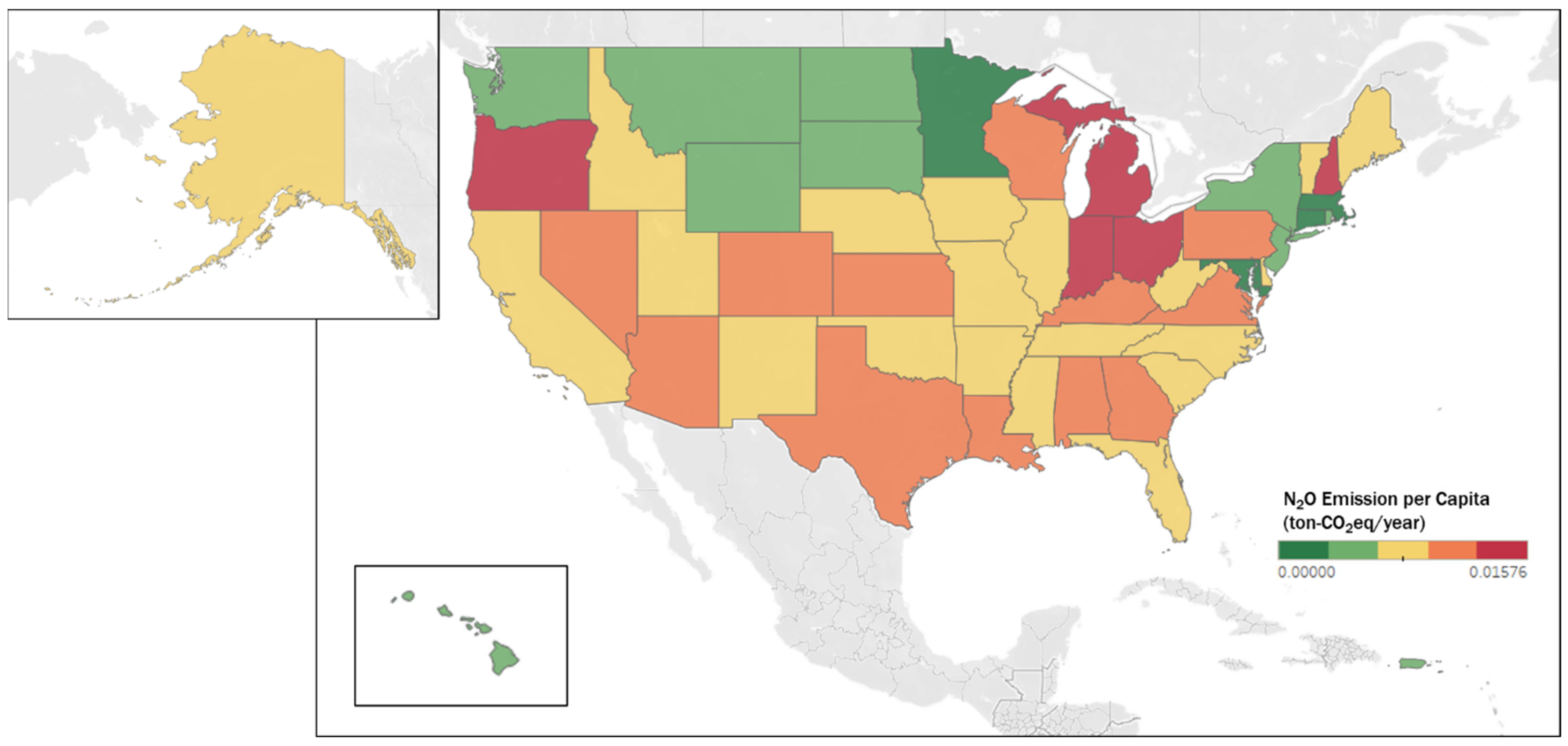

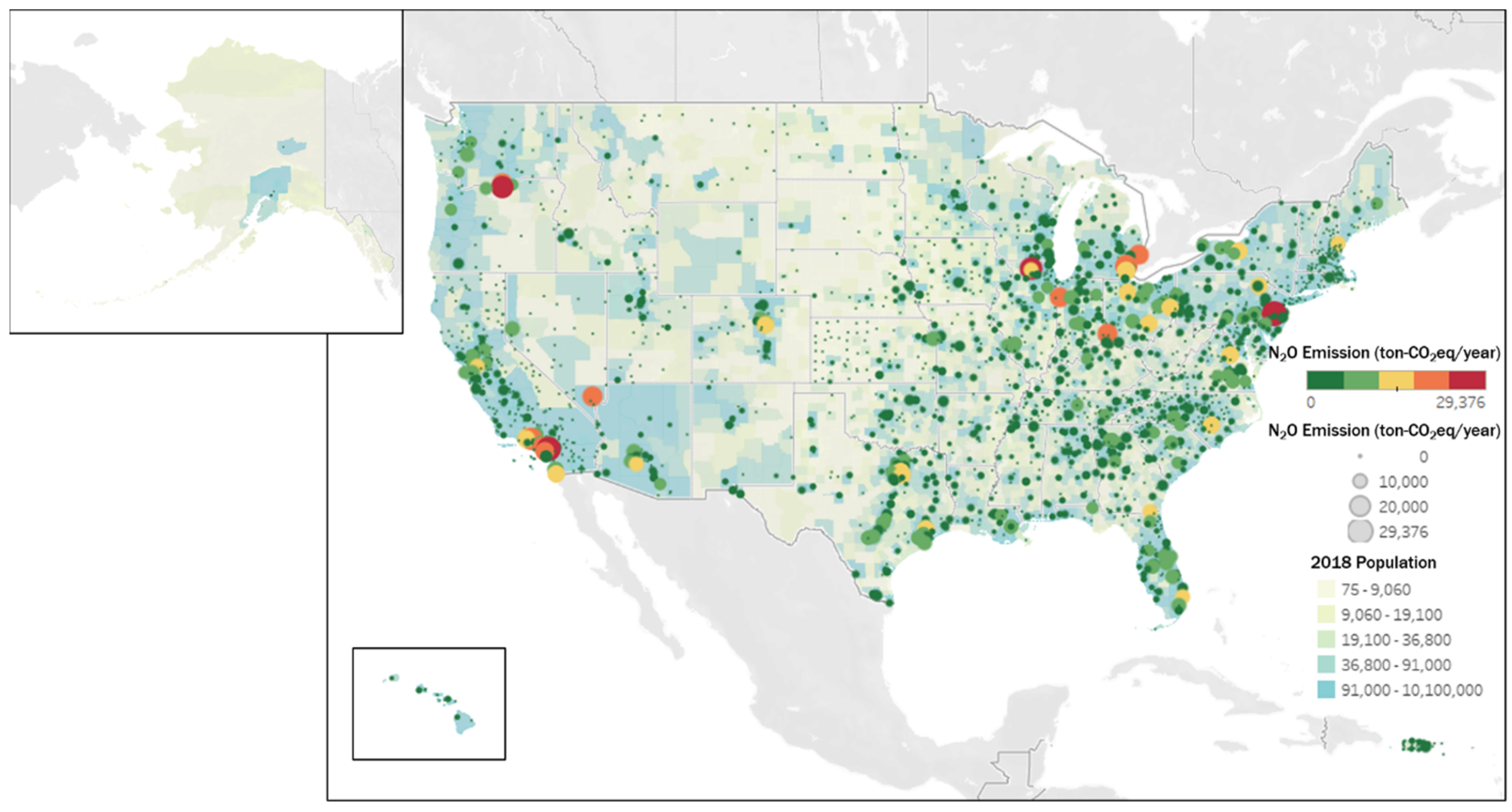
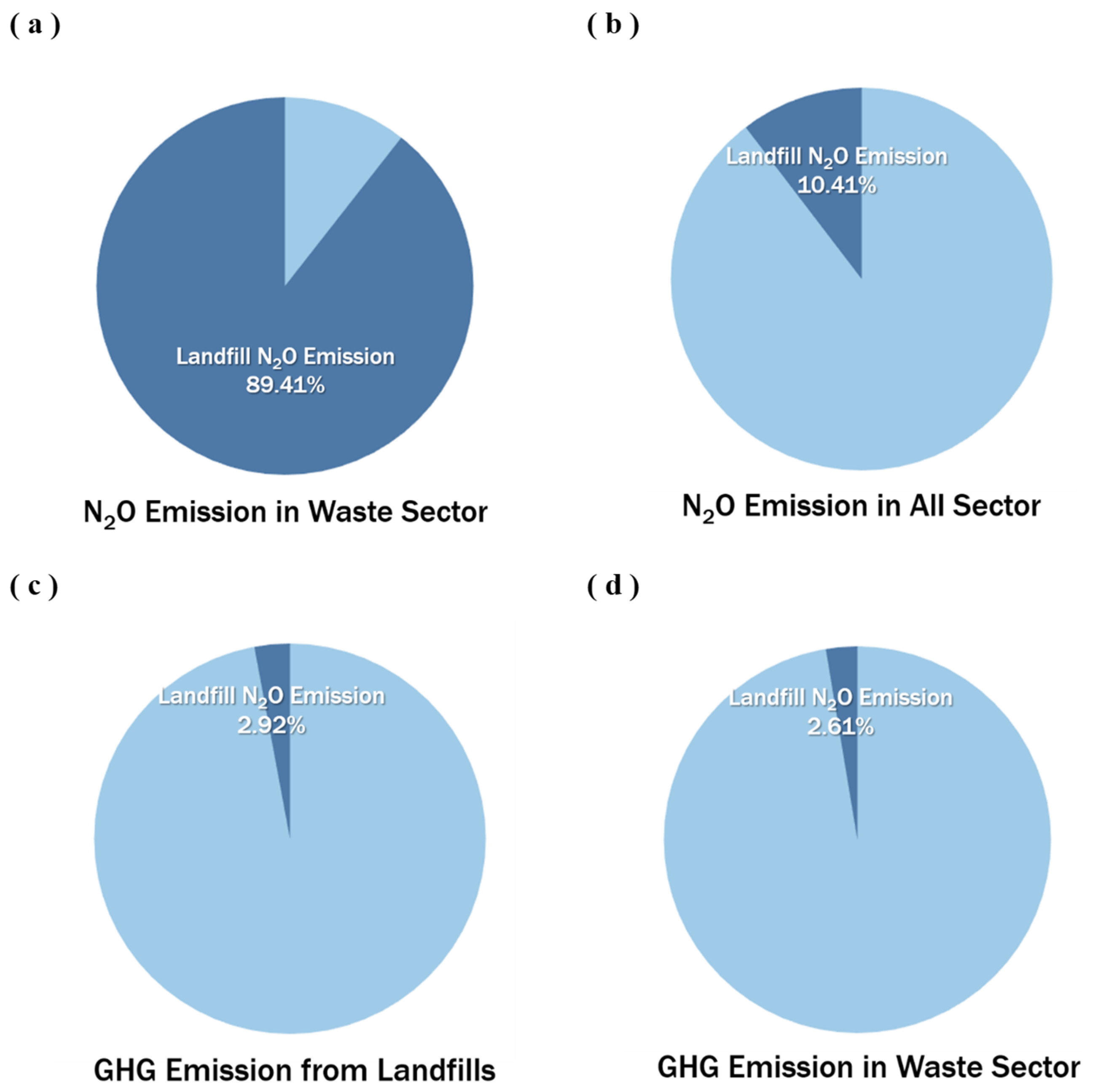
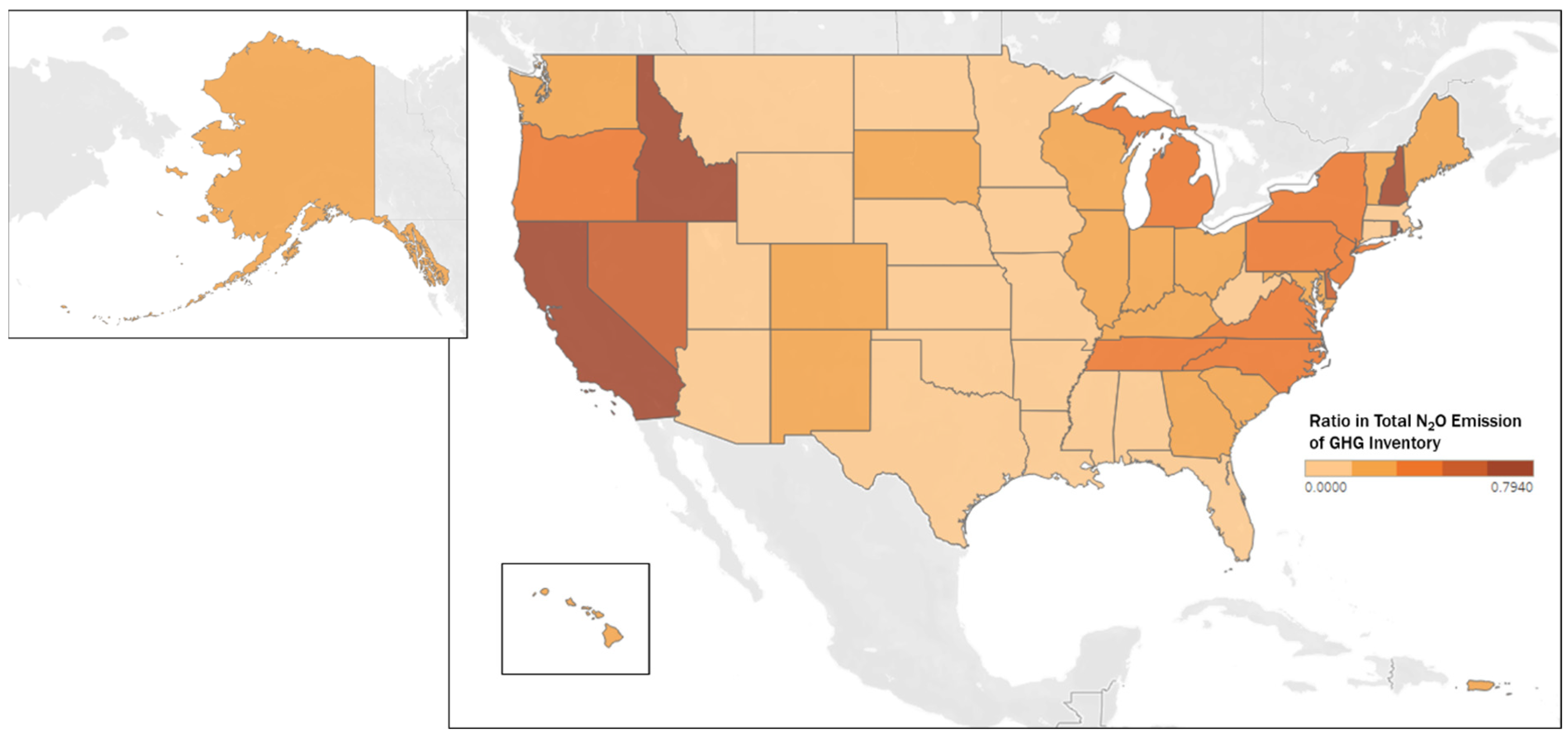
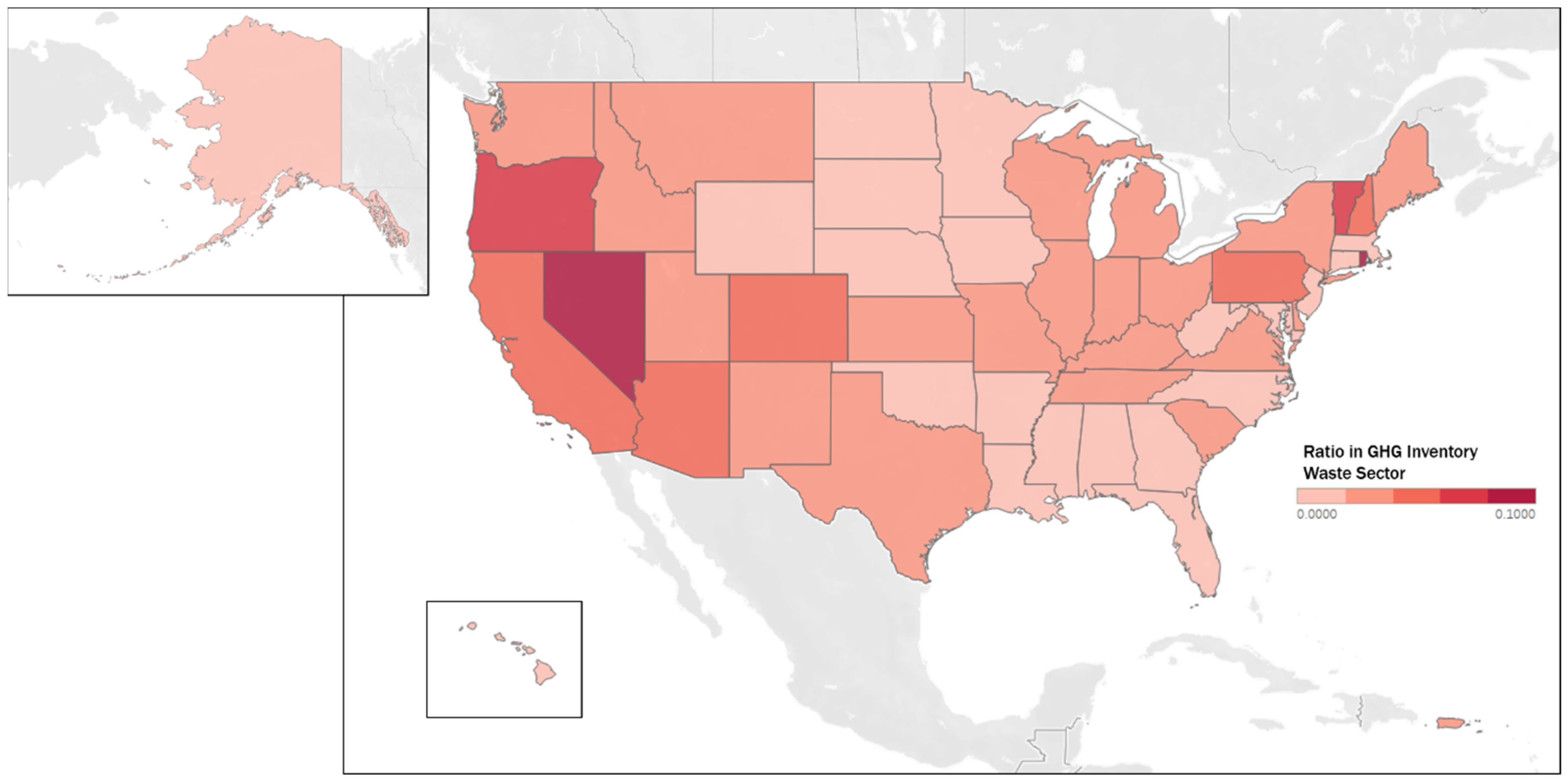
| Variables | Meaning | Unit | References | Applied Value |
|---|---|---|---|---|
| a | Planned minimum stabilization period of the landfill | years | Mudhoo et al. (2013) [43] | 5.5 |
| Wi | Total amount of landfill waste in landfill category i | ton | ||
| RO | Ratio of organic waste to total landfill waste | % | ||
| EF1 | N2O emission coefficient for landfilled organic waste | Ton-N2O/ton-waste | 2006 IPCC GL [44] | 0.00024 |
| EF2 | N2O emission coefficient for landfill aeration and stabilization | Ton-N2O/ton-waste | CDM AM0083 [41] | 0.000027 |
| GWPN2O | Global warming potential of N2O | Ton-CO2eq/ton-N2O | IPCC Second Assessment Report [45] | 310 |
| State | Organic Ratio (%) | Items Included in Organic Matter | Reported Year |
|---|---|---|---|
| U.S. Average | 62.5 | Paper, Rubber, Leather, Textile, Wood, Food Waste, Yard Trimming | 2018 |
| Alaska | 66.10 | Paper, Rubber, Leather, Textile, Wood, Food Waste, Yard Trimming | 2015 |
| Alabama | 70.40 | Paper, Yard Waste, Wood, Food Waste, Textiles, Diapers, Fines, Other Organics | 2012 |
| Colorado | 56.30 | Paper, Food Waste, Yard Waste, Clean Wood, Other Organics | 2018 |
| Delaware | 61.13 | Paper, Vegetative Food Waste, Protein Food Waste, Food Waste in Plastic Packaging, Food Waste in Other Packaging, Leaves, Grass, Brush, Branches and Stumps, Textiles, Rubber/Leather, Diapers and Sanitary Products, Carpet and Carpet Padding, Remainder/Composite Organic | 2017 |
| Iowa | 55.80 | Paper, Food Waste, Textiles and Leather, Diapers, Rubber | 2017 |
| Illinois | 61.10 | Paper, Textile, Yard Waste, Food Scraps, Bottom Fines and Dirt, Diapers, Other Organic | 2015 |
| Indiana | 65.26 | Paper, Textile, Leather, Rubber, Wood, Food Waste, Yard Trimming, Diapers, Fines | 2012 |
| Michigan | 61.36 | Paper, Textile, Food Waste, Yard Waste, Soil, Wood, Other Organics | 2016 |
| Minnesota | 58.15 | Paper, Textile, Leather, Yard Waste, Food Waste, Wood, Other Organic Material | 2013 |
| Missouri | 62.71 | Paper, Textile, Food Waste, Wood, Disposable Diapers and Sanitary Prod., Yard Waste, Remainder/Composite Organic | 2018 |
| Rhode Island | 56.90 | Paper, Textile, Branches and Stumps > 2 inches, Leaf and Yard Debris, Clean Dimensional Lumber, Vegetative Food Waste, Protein Food Waste, Other Organics | 2015 |
Disclaimer/Publisher’s Note: The statements, opinions and data contained in all publications are solely those of the individual author(s) and contributor(s) and not of MDPI and/or the editor(s). MDPI and/or the editor(s) disclaim responsibility for any injury to people or property resulting from any ideas, methods, instructions or products referred to in the content. |
© 2024 by the authors. Licensee MDPI, Basel, Switzerland. This article is an open access article distributed under the terms and conditions of the Creative Commons Attribution (CC BY) license (https://creativecommons.org/licenses/by/4.0/).
Share and Cite
Na, Y.; Byun, K. Estimation of Potential Nitrous Oxide Emissions from Landfills in the United States: 2010–2020. Sustainability 2024, 16, 4810. https://doi.org/10.3390/su16114810
Na Y, Byun K. Estimation of Potential Nitrous Oxide Emissions from Landfills in the United States: 2010–2020. Sustainability. 2024; 16(11):4810. https://doi.org/10.3390/su16114810
Chicago/Turabian StyleNa, Youngrin, and Kyuhyun Byun. 2024. "Estimation of Potential Nitrous Oxide Emissions from Landfills in the United States: 2010–2020" Sustainability 16, no. 11: 4810. https://doi.org/10.3390/su16114810






